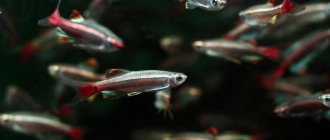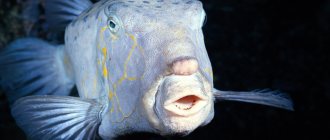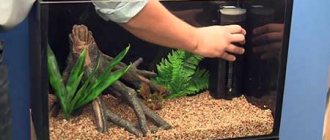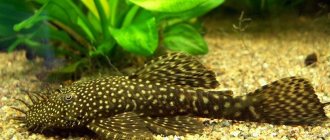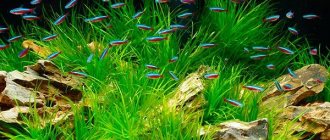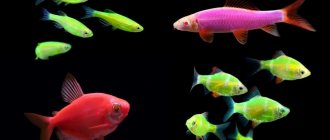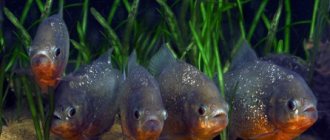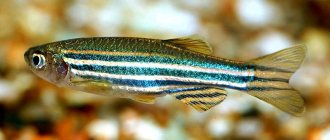Description
Body color varies, but most species are red-golden. The abdomen is always lighter than the main color. The goldfish has a round shape, small in length, depending on the specific species, the body is compressed on the sides. The scales can be of different sizes, all individuals have teeth and large gill covers.
The characteristics regarding the shape of the fins and tail of the fish depend on the variety; there are veil-tailed individuals and those with ribbon-like fins, which look impressive while moving in the water. The eyes are usually of a standard size, but the shape of the apples is convex.
For fish to reproduce, a male and a female are needed. There are no viviparous species among goldfish. All fry emerge from eggs.
Such an individual will look good in any aquarium and will decorate every artificial reservoir. Every aquarist should have at least one goldfish in his collection, thanks to its unusual beautiful appearance.
Dimensions
The fish grow in an aquarium to small sizes; as a rule, the length of the body without a tail is no more than 15 cm. In large reservoirs, the golden individual grows better and can reach 40 cm. The length of the fins varies significantly depending on the species. By creating good conditions for keeping goldfish, healthy and active growth of the individual is ensured.
Life expectancy also depends on size. The shortest individuals live less, within 15 years, while long-bodied representatives can live up to 40 years.
Motherland
Aquarium goldfish are a type of freshwater fish, bred in artificial conditions, belonging to the genus of crucian carp. They were first bred in the East, so the birthplace of goldfish is China and Korea.
Reproduction
Puberty in goldfish begins after one year of life. But full development will occur only after 2-4 years, so fish should be bred at about this age.
An aquarium with a volume of 20 liters to 50 liters should be used as a spawning tank. The water level should not be higher than 20 cm. The water should be clean, fresh, settled and quartzized.
You can also leave it in direct sunlight for several hours. The spawning tank must have strong aeration and bright lighting.
At a height of about 2 cm above the bottom, you need to install a plastic mesh, and place a nylon sponge or a large bunch of thread in one of the corners of the aquarium. After planting the fish in the spawning tank, the temperature will need to be gradually increased by 2-4°C.
In order for spawning to be guaranteed and the eggs to be completely fertilized, it is recommended to take two or three males per female.
You can also arrange group spawning for a school of fish. The mark lasts 2-5 hours. During this time, the female is capable of laying 2-3 thousand eggs.
The eggs stick to the washcloth or fall to the bottom of the aquarium, under the net, where the fish cannot reach and eat them. After the end of spawning, the parents must be removed from the spawning tank. The incubation period takes place at 24-25°C and lasts four days. During this period, whitened and dead eggs should be removed. Then the larvae emerge from the eggs.
They are still completely helpless, they look like thin strings with eyes and a yolk sac, which contains a supply of food for the first days of life.
These larvae move around the aquarium in jerks, attaching themselves to the place they touch. In this case, small larvae most often remain in a vertical position, with their tail down.
After about three days, the larvae will reach the surface of the water, where they will fill their swim bladder with air, after which they will be able to take a horizontal position, move normally and feed on their own.
In addition to fish, you can brighten up your life by having a cat or dog in your home.
Varieties
Selective breeding has achieved great results; the goldfish family has about 300 varieties. Goldfish differ in color, shape, size and type of fins.
The most popular types of breeds:
- Ordinary. Contained in indoor aquariums and open containers, the color of the scales is red-orange, the body length reaches 40 cm.
- Veiltail. It has a long tail fin and enlarged eyeballs, and is calm and leisurely.
- Fish telescope. A distinctive feature is large eyes; the shape of the eyeballs differs depending on the species.
- Jikin butterfly. The fin has a forked shape, reminiscent of butterfly wings. Representatives are only divorced at home.
- Ranchu. It is distinguished by a flattened body and small fins; there are no fins on the back.
- Ryukin. It has a curved back and is extremely slow in its movements. Loves warm conditions.
- Oranda. Outwardly it resembles a telescope, but on the forehead it has a fatty growth in the form of a golden cap.
- Bubble Eye. The fish has characteristic bags around the eyes, which are filled with liquid; their size can reach 25% of the size of the entire fish.
- Pecilia. It has a diamond-shaped body and a wide caudal fin, the head is small compared to the body. The most popular species for keeping in home reservoirs.
Tank selection
Before buying a pet for an artificial pond at a pet store, you should figure out what kind of aquarium is needed for a goldfish and how to properly equip it. To do this, you need to accurately calculate what size it will reach. Also, when choosing an aquarium, you need to consider the following nuances:
- The volume of water must be at least 50 liters per individual.
- The tank has a traditional shape - a parallelepiped. The length is twice the height, and the height is equal to the width.
- When keeping and caring for aquarium goldfish, it is necessary to take into account that they cannot be placed in containers with curved glass. Because of this, the world for aquatic inhabitants is distorted, and they feel uncomfortable.
- The soil at the bottom should not be shallow, as fish like to dig in it and can swallow pebbles and die. Sand can be used as soil.
You can use sand or small pebbles as soil. - It is necessary to maintain the water temperature within 18-30 degrees Celsius: for long fish it should be 18-25 Celsius, for short ones - 21-29 Celsius. Salinity should be maintained at 12-15%. The hardness must be at least 8.
- The aquarium should be equipped with round-the-clock aeration.
- Constant water filtration should be ensured. Since fish like to dig through the soil, turbidity rises to the top. The filter capacity should be 3-4 aquarium volumes per hour. Both external and internal filters are suitable and should be washed at every water change.
- The water is changed every week, and a quarter to a third of the volume of the container is changed.
The water in the aquarium should be changed every week - To regularly clean the soil you need a siphon.
- An ultraviolet water sterilizer can also be helpful. By killing parasites and bacteria, it prevents external algae from blooming.
- An artificial pond must contain safe decorative elements: stones and various objects without sharp corners, plants without sharp leaves.
- You need to take care of the availability of plants. They are not only decoration, but also a good way to combat algae. Plants are also capable of absorbing nitrogen and supplying water with oxygen. They serve as a treat for aquarium pets, saturating their bodies with useful microelements. It is better to choose plants with hard leaves (elodea, fern, lemongrass, anubis) and plant them in pots so that the fish do not damage their roots while digging the soil.
- Before placing fish in the aquarium, you need to “start” it. A young or improperly started tank will lead to death or poisoning of its inhabitants.
How to care
Goldfish are unpretentious individuals; care and maintenance must be regular. Goldfish need clean water, they tolerate fresh water well, with a short settling time. Features of the content are related to the life activity of the individual. Due to the active growth of algae inside the reservoir, they should be removed and the container glass should be regularly cleaned of them. Plants need to be thinned and pruned once a week.
Keeping goldfish does not require complex and unusual procedures; the manipulations consist of maintaining regular cleanliness inside the reservoir to ensure a quality life for pets.
Feeding goldfish
When keeping fish of this type at home, it is necessary to provide varied feeding, but you should not add live or frozen food to the diet. Due to the constant consumption of high-protein foods, goldfish can develop gastrointestinal diseases. Also, you should absolutely not try to diversify the fish’s diet with vegetable cereals (wheat, rice, oatmeal), since the water will become polluted very quickly because of them.
High-quality dry food is best suited for goldfish, as it is balanced, safe and cannot be a source of infection. It is important not to forget that the plant component should be the basis of the goldfish diet.
Who does he get along with?
Goldfish prefer to live with similar individuals. It is also not recommended to place fish of different body lengths in one vessel. Different species differ not only in body size, but also in character.
If golden representatives are placed with other species of fish, there will be a risk of damage to the fins, since golden individuals need a lot of space. There are species of fish that are very small in size, so goldfish can easily eat them.
Despite the fact that goldfish are peaceful fish, it is important to know that combining them with other species reduces their life expectancy and health. As a result, compatibility with other fish becomes a difficult task.
Restrictions
Very rarely, beginners think for a long time about arranging an aquarium. Most often, they buy bright soil, equipment that the seller recommends, and some beautiful castle (which often looks out of place in an aquarium). If you plan to put a goldfish in your container, you need to be careful even when choosing soil. Small stones are definitely not suitable. Veiltails will constantly stir them up, picking up dirt from the bottom. There is another problem: these fish often swallow small pebbles and in order to save them, real operations have to be carried out to remove the foreign object with tweezers.
